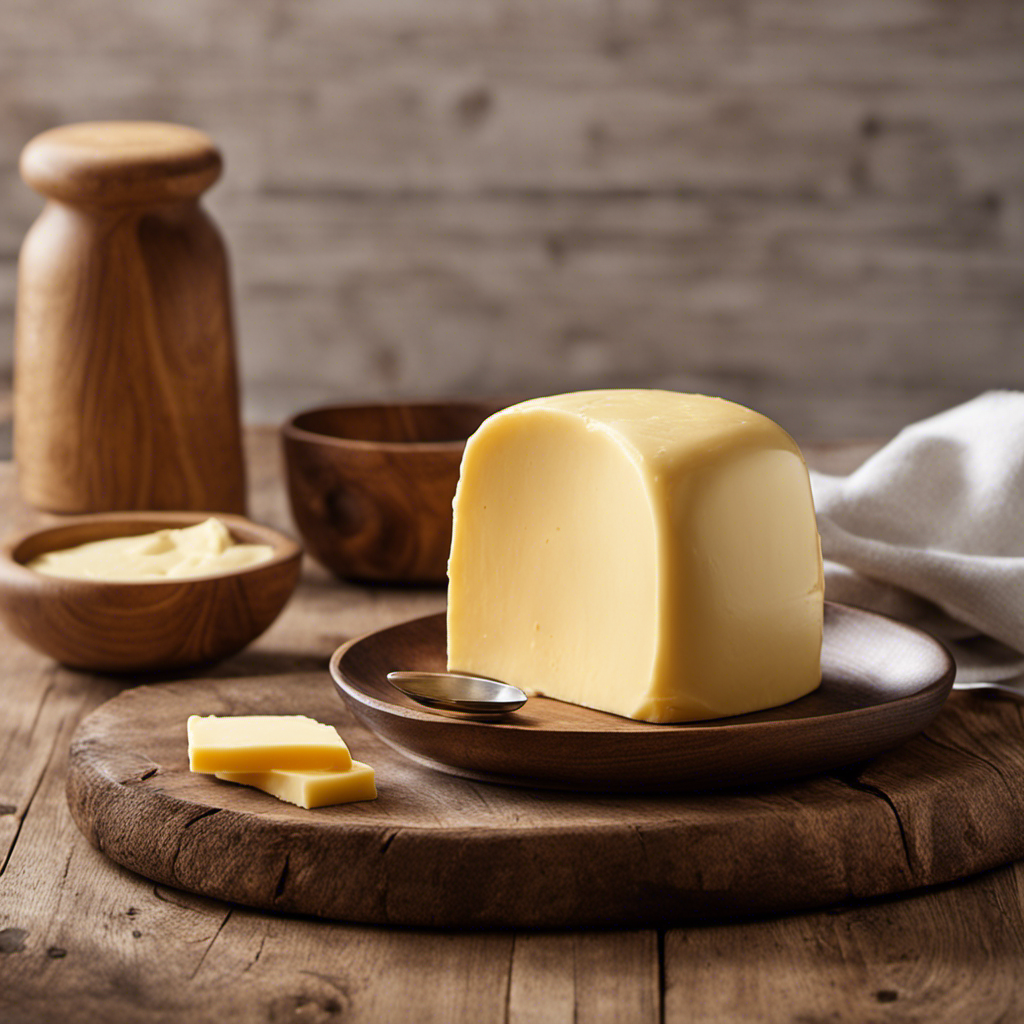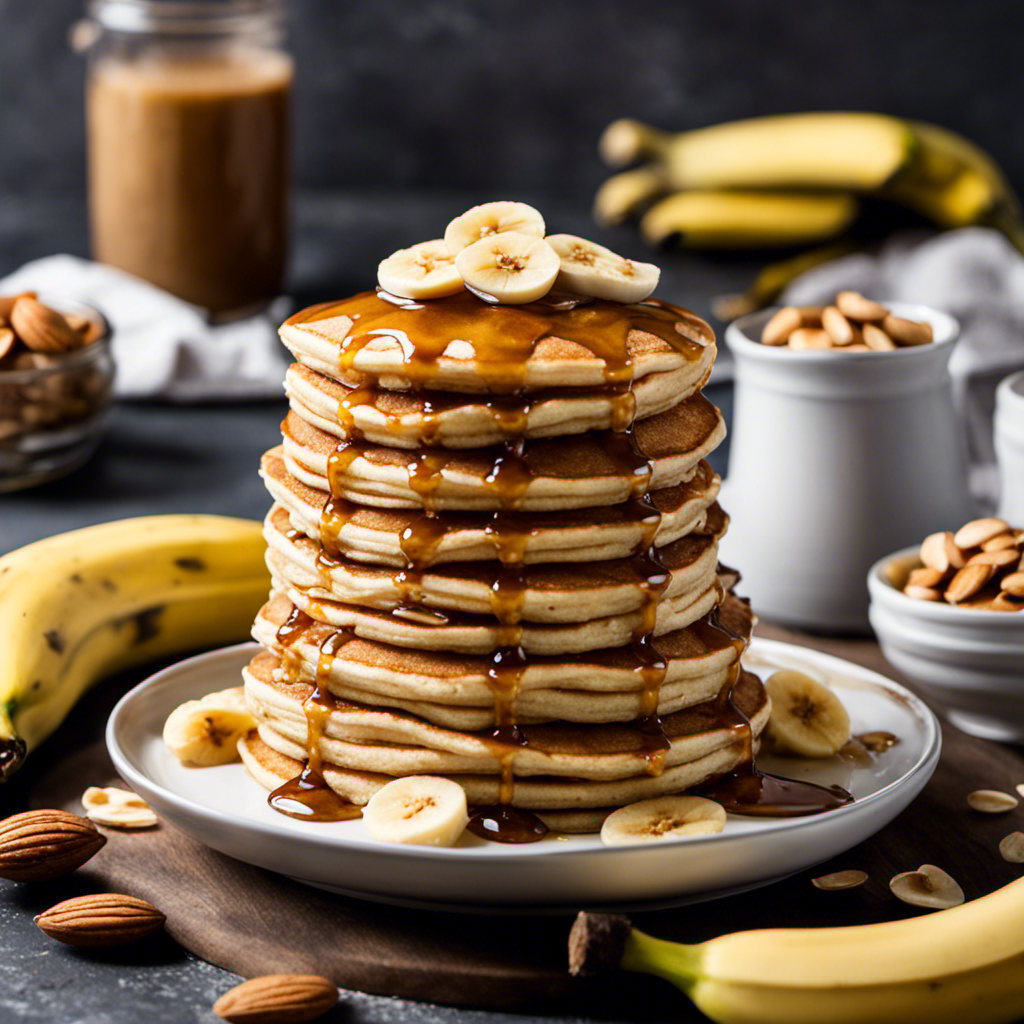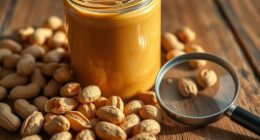When exploring organic butter, it’s important to go beyond the label and understand certification standards you might not know about. These include strict USDA and EU organic standards that restrict GMOs, synthetic pesticides, and promote animal welfare and soil health. Third-party audits verify compliance, ensuring transparency and authenticity. Packaging and ingredient sourcing also follow rigorous rules to maintain product integrity. Keep uncovering these hidden standards to truly appreciate what makes organic butter so trustworthy.
Key Takeaways
- Certification standards vary globally, with USDA Organic, EU Organic, and other regions enforcing different rules on GMO use and processing.
- Third-party audits verify compliance through inspections, record reviews, and ingredient sourcing checks to maintain certification integrity.
- Organic farming practices emphasize soil health, water conservation, and animal welfare, which directly influence butter quality and sustainability.
- Ingredient integrity is ensured via strict non-GMO verification, traceability, and supply chain documentation to prevent contamination.
- Packaging and processing must meet specific standards, avoiding synthetic additives and non-organic materials to protect product authenticity.
The Role of USDA Organic Certification in Butter Production
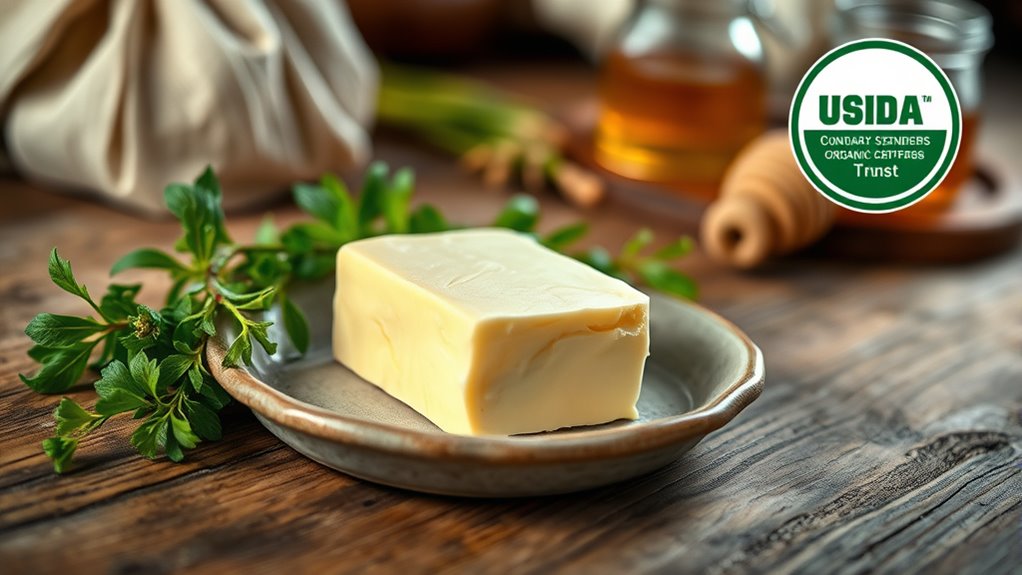
The USDA Organic certification plays a crucial role in ensuring that butter labeled as organic meets strict standards for production. This certification guarantees that dairy farmers follow specific organic practices, including no synthetic pesticides or fertilizers, and maintaining proper animal welfare. The organic certification process also enforces dairy standards that restrict the use of antibiotics and synthetic growth hormones, ensuring the milk comes from healthy, well-cared-for cows. When you see USDA Organic on your butter, you can trust it adheres to these rigorous guidelines, which support sustainable farming and healthier products. This certification not only assures quality but also promotes transparency in how your butter is produced, giving you confidence in choosing truly organic dairy products. Certification standards are designed to ensure consistency and integrity across all organic dairy products, including butter.
EU Organic Standards and Their Impact on Dairy Products
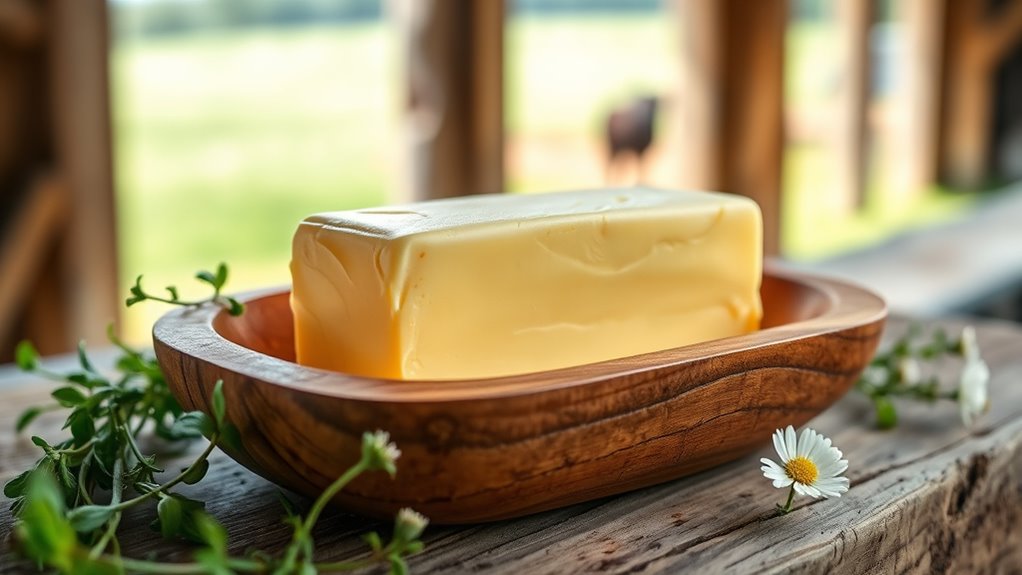
EU Organic Standards set rigorous guidelines that considerably influence how dairy products like butter are produced and marketed within Europe. These standards prohibit the use of genetic modification in feed and restrict pesticide residues, ensuring safer, more natural products. You’ll notice that dairy farms must maintain high animal welfare and environmental practices, reflecting consumer concerns about chemical use and genetic integrity. Dual-flush standards help promote water efficiency in dairy farm operations, aligning with overall sustainability goals. Dairy cows graze on organic pastures, avoiding genetically modified crops. Feed must be free from pesticides and synthetic additives. Certification ensures no genetic modification or harmful pesticide residues are present in the final product. These strict rules protect butter consumers from chemical contaminants and genetic alterations, promoting transparency and trust. As a result, European dairy products meet high-quality standards that influence global markets and consumer preferences.
The Significance of Soil Health Certifications in Organic Dairy Farming
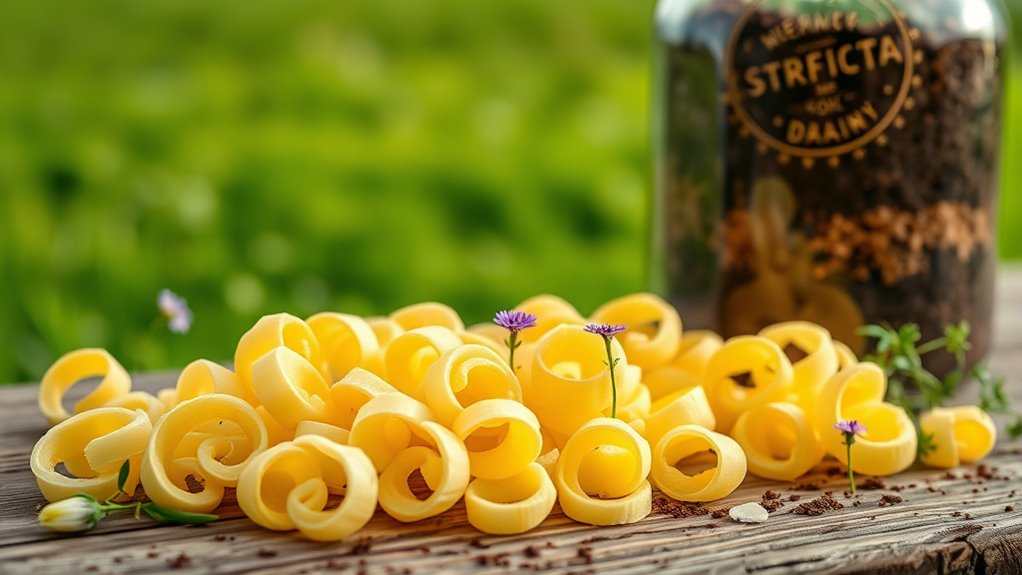
Since healthy soils form the foundation of sustainable organic dairy farming, soil health certifications have become increasingly important for producers aiming to meet strict organic standards. These certifications focus on maintaining soil fertility through practices like crop rotation, which prevents soil depletion and reduces reliance on synthetic inputs. Healthy soils promote robust pasture growth, providing better nutrition for your dairy cows and improving milk quality. Certification programs often require you to demonstrate that your land undergoes regular crop rotation to manage pests, improve soil structure, and enhance organic matter. By prioritizing soil vitality, you not only meet certification requirements but also ensure long-term farm productivity. Incorporating soil testing helps monitor soil health and guides management practices for sustained organic integrity. This commitment to soil vitality helps sustain organic integrity and supports the overall health of your dairy operation.
Animal Welfare Certifications That Influence Organic Butter Quality
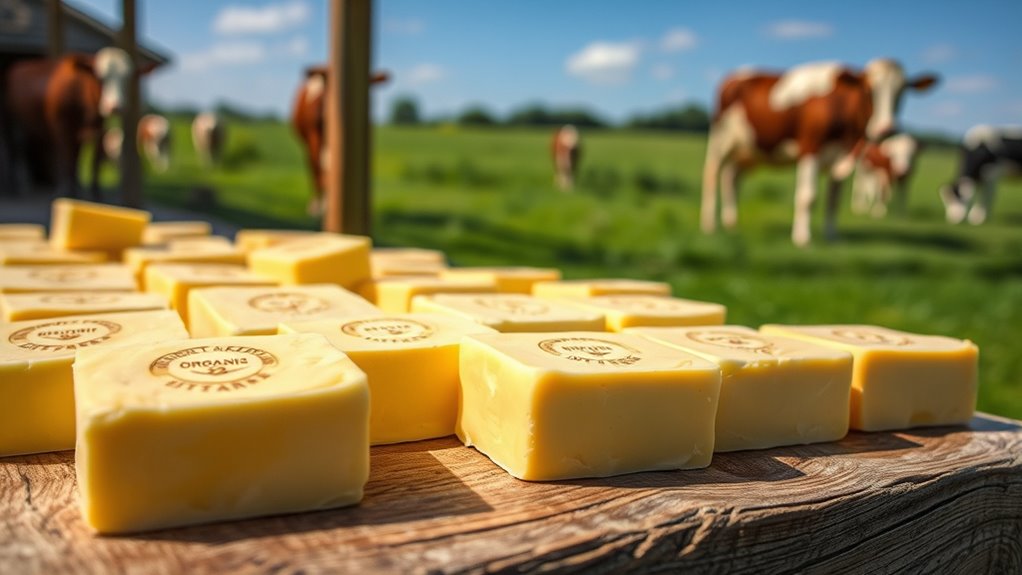
Animal welfare certifications play a crucial role in ensuring the quality of organic butter because they verify that cows are raised under humane and stress-free conditions. Your choice of dairy breed, for example, impacts milk quality and overall well-being. Certifications often emphasize organic pasture management, ensuring cows graze freely on lush, pesticide-free land, promoting natural behaviors. These standards also prioritize proper shelter, fresh water, and minimal stress, leading to healthier cows and richer milk. When you select organic butter with animal welfare certification, you’re supporting ethical farming practices that improve butter flavor and texture. Look for labels that specify humane treatment, pasture access, and breed suitability to ensure you’re getting the highest quality organic butter. Your choices make a difference in animal lives and product integrity. Additionally, ring security cameras can be used by farmers to monitor animal welfare practices and ensure compliance with certification standards.
The Importance of Non-GMO Verification for Organic Dairy Ingredients

You need to understand how non-GMO feed sources and verification standards protect the integrity of organic dairy ingredients. These processes guarantee that your butter isn’t contaminated with genetically modified components. When verification is thorough, it guarantees that the product meets strict organic standards and maintains quality. Additionally, community support features in tracking applications can help producers stay aligned with organic certification requirements.
Non-GMO Feed Sources
Ensuring that dairy animals consume non-GMO feed is essential for maintaining the integrity of organic butter. You need to verify that feed sources are free from genetically modified ingredients, supporting organic standards. Non-GMO feed sources typically include:
- Certified organic grains grown without genetic modification
- Leguminous plants like alfalfa and clover
- Pasture grazing from non-GMO cultivated land
Verification Process Standards
Verifying that dairy ingredients meet non-GMO standards requires a rigorous and transparent process. Certification bodies conduct thorough audits, reviewing feed sourcing and farm practices to guarantee no genetically modified ingredients are used. Regular testing for pesticide residues helps confirm that no harmful chemicals have contaminated the product, maintaining safety and integrity. Label transparency is vital; certifiers verify that labels accurately reflect non-GMO status, giving you confidence in what’s on the package. This process also involves tracking supply chains and documentation to prevent any GMO contamination. By adhering to strict standards, producers demonstrate their commitment to organic integrity, ensuring your organic butter truly aligns with non-GMO principles. The contrast ratio of the verification process helps ensure that all aspects of non-GMO compliance are clearly distinguishable and maintained throughout production. This verification process safeguards consumer trust and reinforces the credibility of organic certification.
Impact on Product Integrity
How does non-GMO verification impact the integrity of organic dairy products? It guarantees your butter stays true to organic standards, safeguarding flavor enhancement and consumer trust. When dairy ingredients are verified non-GMO, you can be confident that no synthetic genes or modifications have compromised the product’s purity. This verification also supports AP Tuning packaging sustainability by reducing reliance on genetically engineered crops, which often involve environmentally harmful practices.
Water Use and Conservation Standards in Organic Farming Practices
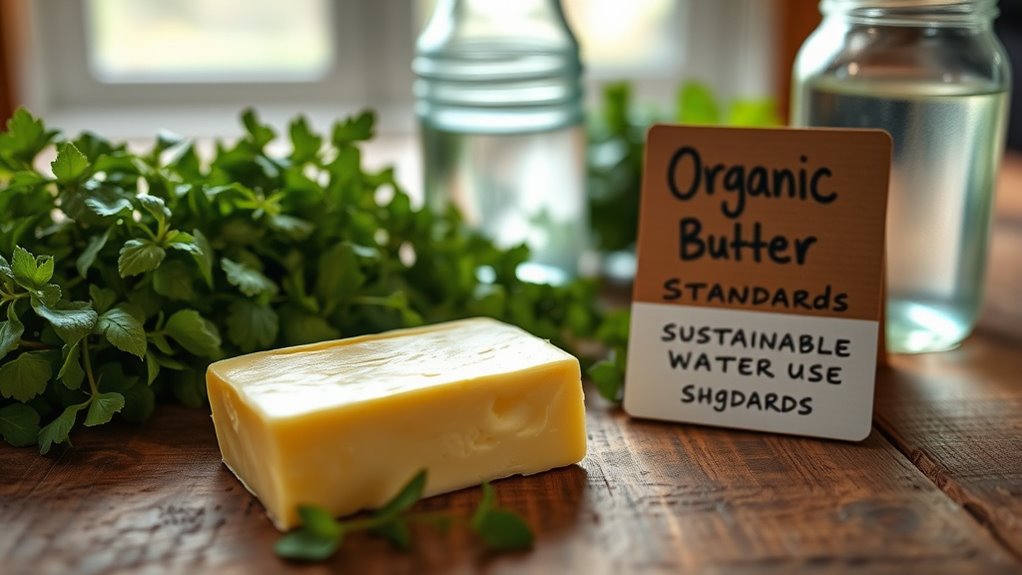
Water use and conservation are crucial components of organic farming practices, aiming to minimize environmental impact while maintaining crop health. Organic standards emphasize efficient water management through practices like water conservation and improved irrigation efficiency. By adopting drip irrigation or scheduling watering based on weather conditions, you can reduce waste and ensure crops get exactly what they need. Here’s a quick overview:
| Water Conservation Methods | Benefits |
|---|---|
| Drip Irrigation | Reduces water waste, improves efficiency |
| Rainwater Harvesting | Lowers reliance on external water sources |
| Soil Moisture Monitoring | Ensures ideal watering, prevents runoff |
| Mulching | Conserves soil moisture, suppresses weeds |
Additionally, understanding the water footprint of various farming practices helps in selecting the most sustainable options for water use.
Traceability Requirements: Ensuring Authentic Organic Butter
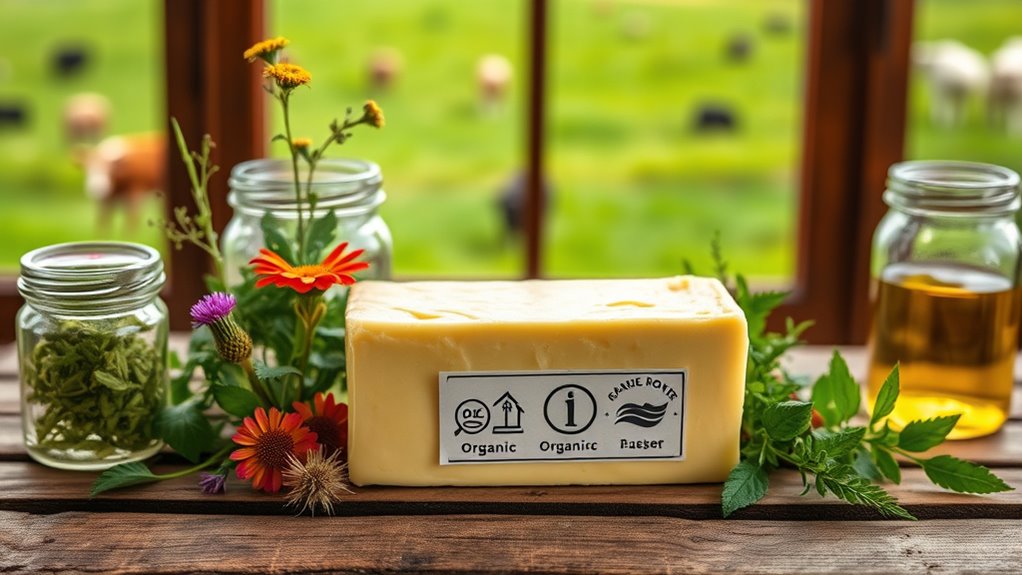
Maintaining transparent traceability is essential to confirm that organic butter meets established standards from farm to table. This process ensures you receive authentic organic flavor and milk purity, free from contamination. Traceability involves tracking every step, from pasture grazing to processing, so you can trust the product’s origins. Implementing filter replacement indicators and regular quality checks further verify that standards are consistently upheld throughout the supply chain. These measures help safeguard the integrity of organic butter, ensuring it’s truly organic and meets rigorous certification standards. By maintaining clear records, producers demonstrate their commitment to transparency, giving you confidence in the organic quality and purity of your butter.
Organic Certification for Packaging and Processing Materials
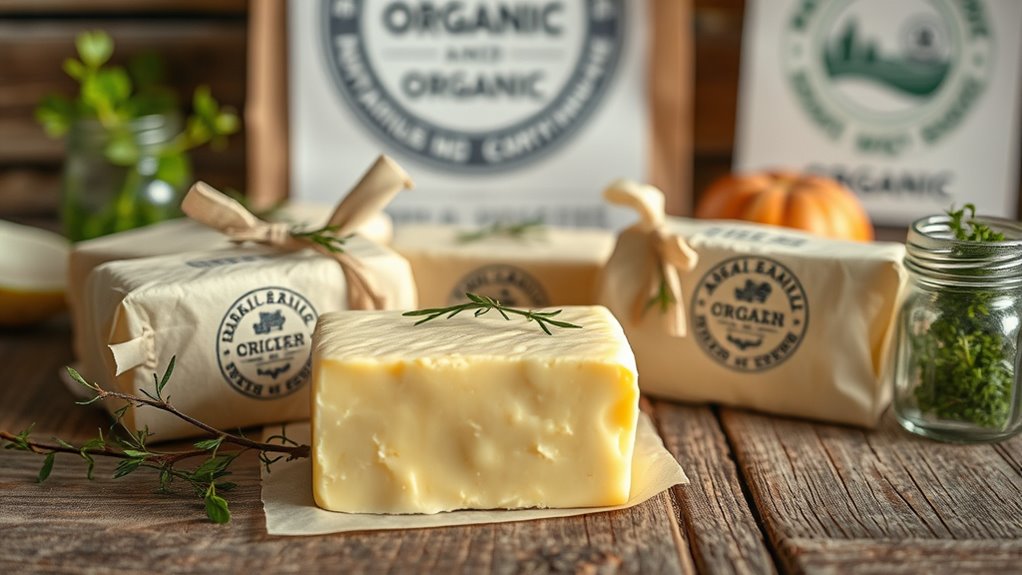
Ensuring that packaging and processing materials meet organic certification standards is essential for preserving the integrity of organic butter. Packaging regulations specify that materials must avoid synthetic dyes, plastics, or non-organic additives, guaranteeing they don’t compromise the product’s organic status. Processing standards mandate handling procedures that prevent contamination with non-organic substances, maintaining purity throughout production. Certified packaging materials often include biodegradable or recyclable options aligned with organic principles. You need to verify that all materials used in packaging and processing are certified organic and comply with relevant regulations. This not only protects the product’s integrity but also builds consumer trust in your brand. Staying current with packaging regulations and processing standards helps ensure your organic butter remains authentic and compliant at every step. Additionally, understanding electric dirt bike horsepower can offer insights into the importance of maintaining product quality and performance standards in organic production.
International Organic Standards and How They Differ
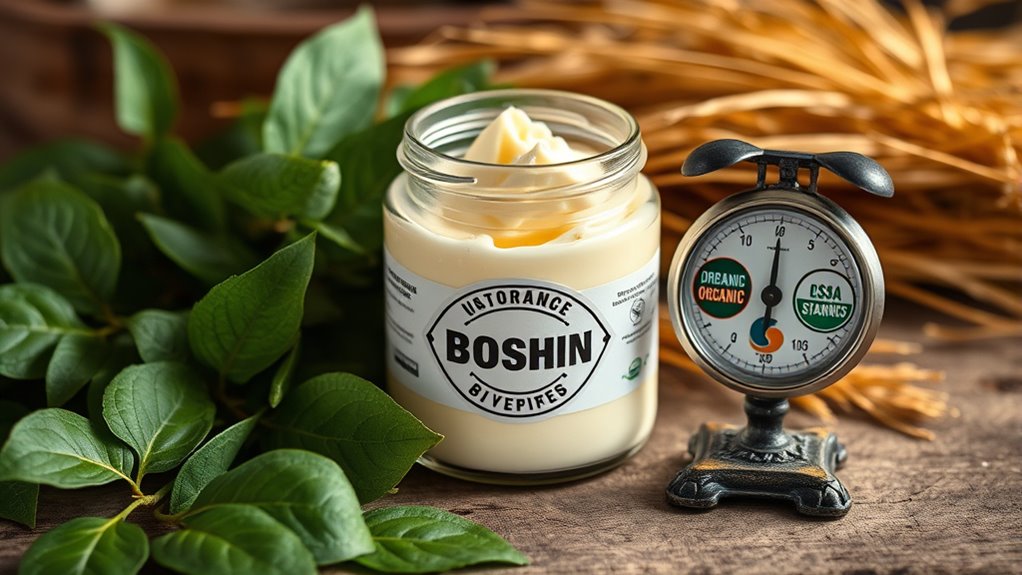
Different countries have established their own organic standards to regulate production, processing, and labeling practices. These standards can vary markedly, affecting what’s allowed in organic butter. For example, some countries permit herbal additives to enhance flavor or shelf life, while others restrict such ingredients. Processing methods also differ; certain regions allow cold-pressing or minimal heat treatments, whereas others require strict limitations to maintain organic integrity. You might notice that organic standards in one country emphasize the use of non-GMO feed, while another emphasizes sustainable farming practices. These variations impact how producers certify their products as organic, influencing consumer choices worldwide. Understanding these differences helps you make more informed decisions, especially when comparing organic butters across borders.
Third-Party Audits and Their Role in Maintaining Certification Integrity
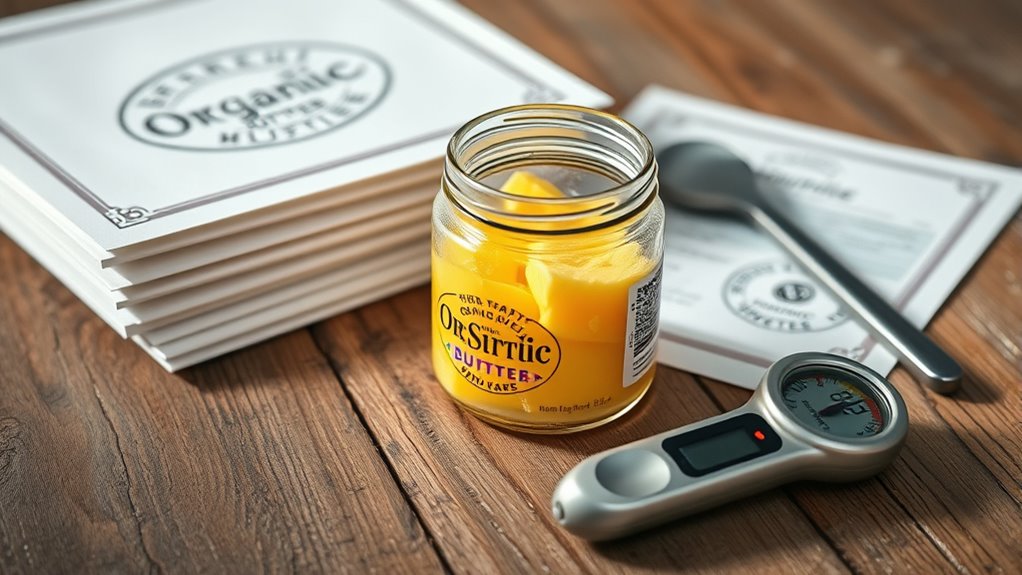
Third-party audits play a essential role in verifying that organic butter producers adhere to established standards. When you undergo third-party verification, an independent organization reviews your practices, guaranteeing compliance with organic regulations. This process is fundamental for certification enforcement because it maintains trust in organic claims. Audits typically include examining records, inspecting facilities, and verifying ingredient sourcing. By conducting regular audits, certifying bodies ensure producers follow the strict guidelines that define organic butter. Your commitment to passing these inspections helps uphold the integrity of the certification. Without third-party audits, false claims could easily slip through, undermining consumer confidence. Ultimately, these audits serve as a key safeguard, guaranteeing that what’s labeled as organic truly meets the standards set by certification authorities.
Frequently Asked Questions
How Do Organic Standards Vary Between Different Countries?
You might wonder how organic standards differ internationally. Countries have unique rules for organic production, affecting international labeling and trade. Certification reciprocity allows some countries to recognize each other’s standards, easing exports and imports. However, differences still exist, meaning a product labeled organic in one country might not meet another’s standards. To guarantee quality, always check the certification details, especially if you’re buying organic products from abroad.
What Are the Penalties for Non-Compliance With Organic Certification?
So, you think skipping certification standards is a free pass? Think again. Penalties enforcement for certification violations can be harsh—fines, product recalls, or even license revocation. The authorities don’t take kindly to breaches, and the consequences escalate quickly. Ignoring these penalties only increases your risk of legal trouble, damaged reputation, and lost trust. Better to follow the rules; the cost of compliance is far less than the price of non-compliance.
Are There Specific Certifications for Organic Butter Packaging?
You should know that there aren’t specific certifications solely for organic butter packaging. However, your packaging labels must meet organic standards, including clear certification logos from authorized agencies. These logos verify your product’s organic status and guarantee compliance with regulations. Proper labeling helps consumers identify authentic organic butter and maintains your credibility, so always double-check that your packaging aligns with certification requirements and displays accurate, recognizable certification logos.
How Does Organic Certification Influence Butter Shelf Life and Storage?
Organic certification influences butter’s shelf stability and storage conditions by ensuring high-quality standards that reduce artificial preservatives. You’ll find that certified organic butter often has a shorter shelf life, so proper storage in a cool, dark place is essential. This certification guarantees you’re getting a product made with natural ingredients, which may require more careful handling to maintain freshness and prevent spoilage.
Can Conventional Dairy Farms Easily Transition to Organic Certification?
Jumping into organic certification isn’t a walk in the park, but it’s doable with the right planning. A conventional shift or farm conversion requires meeting strict standards, such as feed, pasture, and record-keeping. You’ll need patience and dedication, but with proper guidance, your farm can successfully switch to organic. Keep in mind, it’s a process that rewards those willing to put in the effort for better quality and marketability.
Conclusion
So, next time you butter your toast, remember there’s a secret society of certifiers, soil whisperers, and animal welfare detectives working behind the scenes. It’s like a covert operation to keep your organic butter pure and pristine—no GMO spies or shady packaging permitted. So, savor each buttery bite, knowing it’s been through more hoops than a circus performer, all to guarantee you get the crème de la crème of dairy delights.





